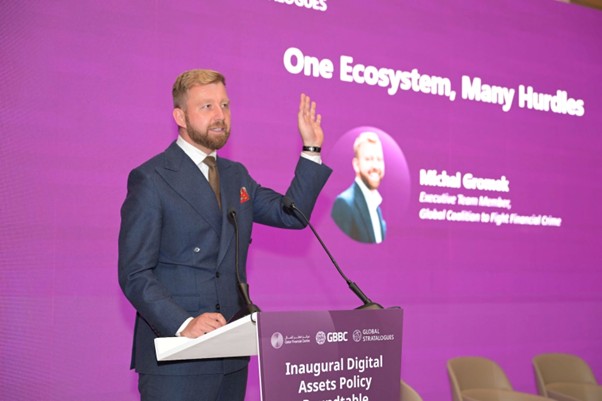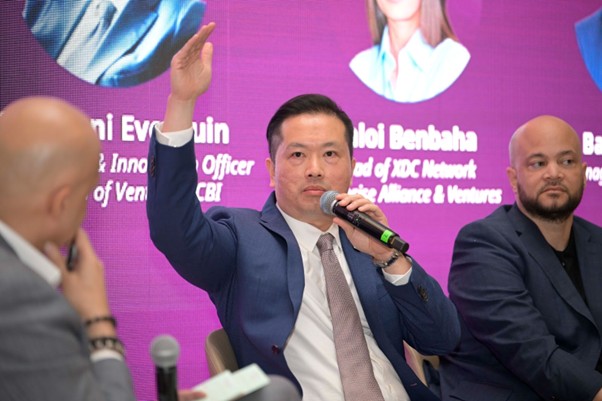QFC & Global Stratalogues Hold Inaugural Policy Roundtable on Regulating Tokenization alongside Qatar Economic Forum
Emphasizing Clarity Amid Complexity for Interoperable and Transparent Regulation

As the global race to tokenize assets accelerates—projected to hit $16 trillion by 2030—Qatar is positioning itself not just as a participant, but as a potential architect of tomorrow’s financial infrastructure. The Inaugural Digital Assets Policy Roundtable hosted by the Qatar Financial Centre in partnership with Global Stratalogues and Global Blockchain Business Council (GBBC), alongside the Qatar Economic Forum, industry experts gathered to discuss how to navigate the maze of conflicting regulations.
Maha Al-Saadi, Head of Regulatory Affairs at QFC and moderator of the roundtable, underscored the policy imperative. “Regulatory clarity is not a luxury—it’s a prerequisite for scalable tokenization,” she said. “Our goal is to bridge global standards with local implementation to ensure digital assets can operate within a trusted and secure environment.”

In the opening remarks, Henk J. Hoogendoorn, Chief Financial Sector Officer at Qatar Financial Centre, said, “We are not here to talk about crypto. We are here to talk about digital assets—real-world tokenization, and the infrastructure that makes it work.”
The distinction was deliberate. Held in partnership with Global Stratalogues and GBBC on the sidelines of the Qatar Economic Forum, the inaugural QFC Digital Asset Policy Roundtable signaled Doha’s strategic intent: to move beyond the hype of cryptocurrency toward the institutional frameworks and regulatory clarity needed to make tokenization viable at scale.
“We’re not afraid to regulate,” Hoogendoorn added. “But we want to make sure we regulate the right things, in the right way, with the right partners.” This pragmatic tone set the stage for a series of nuanced conversations among international regulators, innovators, and policymakers on the real-world challenges and opportunities of tokenized finance.

Among the voices around the table, one perspective cut through the complexity with remarkable clarity. Shaun Swan, Director of Policy at the Qatar Financial Centre Regulatory Authority brought a grounded lens to the thorny issues puncturing a popular misconception. “If you go back 12 years, there was no fragmentation because there was simply no regulation,” he pointed out. Those were the wild west days, when pioneering jurisdictions like Singapore and the UAE stepped into the void with the first serious attempts at crypto frameworks.
Fast-forward to today, and we’re living through what Swan calls a tale of two trends. On the surface, regulations are starting to look more alike—similar language, comparable goals, shared buzzwords. Dig deeper, though, and the picture gets messier.
“There’s still differentiation between legal frameworks and legal definitions,” Swan explained. “So while we’re seeing convergence in headline regulation, once you get into the details, fragmentation remains.”
It’s like different cities all deciding they need traffic lights, but then disagreeing on whether ‘red’ means ‘stop’ or ‘go’.
The good news is that international bodies are stepping up their efforts. Organizations such as the Financial Action Task Force (FATF) and the Bank for International Settlements (BIS) have been publishing guidelines aimed at establishing some semblance of global standards.
Swan welcomes these efforts, but he’s not putting out the champagne just yet. “Standards are being published, but they’re often pitched at a high level,” he noted. “And once you start getting into the weeds of legislation—how to implement those standards—you still see fragmentation.”

Anti-financial crime expert Michal Gromek, Executive Team Member, Global Coalition to Fight Financial Crime, added a dose of reality to the discussion: “Countries implement just before evaluations. It’s like cramming for a university exam.” Anyone who’s watched regulatory compliance in action will recognize this pattern—the last-minute scramble to check boxes rather than build sustainable systems.
When the conversation turned to the Middle East, Swan’s tone shifted to one of cautious optimism. The UAE, in particular, is finding its regulatory rhythm. “We have DFSA, ADGM, VARA—the regulators are watching each other,” he observed.
This isn’t just bureaucratic curiosity. When regulators pay attention to what their counterparts are doing, it creates pressure for consistency and improvement. Zane Suren from Zodia Custody reinforced this point: “Consultation papers are issued; feedback is sought. That kind of proactive engagement is a privilege. There is definitely increasing harmonization.”
It’s the kind of collaborative approach that could serve as a model for other regions still struggling with regulatory silos.

The Digital Currency Dance
One of the session’s most intriguing exchanges centered on a question that has been hovering over the crypto space for years: Can Central Bank Digital Currencies (CBDCs) and stablecoins actually coexist, or is this a winner-take-all scenario?
When it comes to stablecoins, Swan is bullish: “They are the stablecoins of choice. They oil the wheels of payments and settlement. I don’t see them disappearing anytime soon.”
CBDCs, on the other hand, remain something of a wild card. “Many projects started with energy but rowed back,” Swan noted. “It’s difficult to predict where CBDCs end up. But I can’t see them knocking stablecoins out of the equation.”
GBBC’s CEO, Sandra Ro, echoed this pragmatic view. “The on-chain payments piece is going to happen. It’s just a question of form and jurisdiction,” she said. But there’s a catch: “We need interoperability, and we need regulated financial institutions to be able to engage permissionless chains.”
When talk turned to market liquidity—always a hot topic in crypto circles—Swan offered a perspective that cut through the usual hand-wringing. “It’s not a question about liquidity. It’s a question about price. There is always a price at which somebody will act.”Patrick Tan, Chief Strategy Officer at HELIX, pointed to tangible benefits: “Tokenization allows investors to exit early by selling at a discount. That creates real liquidity today—not hypothetically.” He also emphasized inclusion potential: “Southeast Asia has 860 million people. Two-thirds are unbanked. If they had spendable, yield-generating tokens in their wallets—that’s transformative.”

So what should regulators be focusing on in the coming months? Swan didn’t hesitate: “Interoperability across regulatory frameworks. It’s the lack of clarity that makes this space tough. Where rules are clear, capital and entrepreneurs follow.”
Other panelists offered their own priorities, painting a picture of an industry grappling with rapid change on multiple fronts:
Heinz Konzett, Senior Legal Expert from Liechtenstein’s financial regulator wants to tackle DAOs and expand intellectual property rights on blockchain. Michal Gromek called for better cross-border data sharing, noting that “Technology is global. Crime is global. Regulation is not.”
Arjun Vir Singh, Partner and Global Head of Fintech at Arthur D. Little, reminded everyone that insularity is the enemy: “Regulators can’t be inward-focused. They must learn from other jurisdictions.”
Sandra Ro made the pointed observation about regulatory design. “If you don’t help startups get licensed, you entrench incumbents,” she warned. “And on the other end, if you don’t allow traditional finance to compete in stablecoins, you lose balance.”
The session wrapped up with a question that perfectly encapsulated the regulatory challenges ahead: How do you regulate something as amorphous as a Decentralized Autonomous Organization? Gromek’s response: “Someone pays for the server, the domain, the code. It’s not a vending machine. If that vending machine spits out poisoned Coca-Cola, who is responsible?” Konzett offered a glimpse of how one jurisdiction is tackling the problem: “In Liechtenstein, DAOs must have a regulated representative who handles AML duties. It depends on the DAO’s nature—economic or financial.”
As the discussion wound down, Swan returned to the theme that had run throughout the session. “If we can move toward regulatory interoperability, that’s when things start to work. Because clarity is what brings trust. And trust is what unlocks everything else.”
It’s a simple formula, but getting there won’t be easy. The crypto industry is advancing at breakneck speed, while regulatory systems are built for deliberation and consensus-building. The challenge isn’t just technical or legal—it’s fundamentally about coordination across borders, cultures, and competing interests. The inaugural policy roundtable brought together the right people, asking the right questions, with practitioners rolling up their sleeves to figure out how to make things work a little better.





